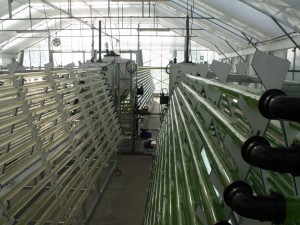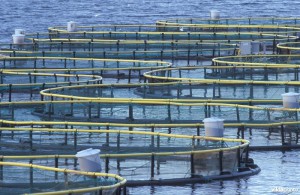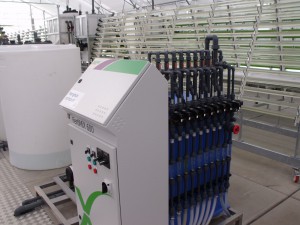Over the next few decades, we’ll be facing the huge challenge of meeting the basic needs of the world’s growing population. Microalgae (microscopic algae) are a promising alternative for the production of biomass. They have a high nutritional value and don’t require fertile soil or fresh water to grow. On 25 september, a continuous photobioreactor for the cultivation of algae was officially unveiled during a seminar at Thomas More University College in Belgium. Both Hortiplan and HortiMaX supplied part of the technology for this project.
Research into large-scale production

Current technologies for large-scale algae production are expensive. This makes growing algae in large quantities a major challenge. Algae require very specific growing conditions, which can be created in a photobioreactor. Under SUNBUILT, an ERDF investment project, VITO and Thomas More college built a closed, continuous photobioreactor for the cultivation of algae. This production unit is connected to a harvest and processing unit that allows compounds of high added value to be extracted from the biomass. Using this new reactor, Thomas More College will examine whether large-scale algae production at low cost is feasible.
The importance of microalgae

Microalgae are microscopic algae, which convert sunlight into energy through the process of photosynthesis. They produce about half the oxygen on Earth, while consuming the greenhouse gas CO2. They also contain important nutrients, such as protein, carbohydrates and unsaturated fats, as well as being a promising source of many high-quality products, such as omega-3 fatty acids, antioxidants, vitamins, carotenoids and other pigments. Thanks to their high nutritional value, they have potential uses as food additives for human, animal and aquaculture consumption, and in pharmaceutical and cosmetic applications. A well-known example of algae use is in salmon farming where the fish are fed saltwater algae rich in omega-3 and vitamin D so they can develop the proper skin colour and distinctive pink flesh. This is necessary in order to sell the salmon in most supermarkets.
Hortiplan and HortiMaX: a unique combination
A call for tenders was launched to find a supplier for the required technology. Eric Scheers of Hortiplan: “When we were asked if we would be interested in collaborating on the algae project of Thomas More college, it was difficult to determine whether Hortiplan could provide added value to such a project.” He continues: “However, in our initial meeting with those in charge of the project, it soon became clear what they had in mind. The aim of the project was to automate four algae reactors using reliable, affordable and professional horticultural technology. And that was right up our street. It’s not for nothing that the reactors are housed in a greenhouse.
“Since they wanted to cultivate both saltwater and freshwater algae, some alterations had to be made so the unit would be capable of preparing the various fertigation recipes. For instance, the EC sensor had to be modified in order to handle the high nutrient concentrations. Thanks to our close working relationship with HortiMaX, we were able to provide them with a solution that met all their needs.” Based on price/performance, we were selected as the best suppliers for this project.
Minor modifications
Since Thomas More College wanted to grow and research both freshwater and saltwater algae, a standard solution would not suffice. For example, the system had to be able to monitor parameters, such as light (PAR), water temperature, nutrient inputs (fertigation), pH value, CO2 level and air intake in the reactor. HortiMaX supplied a FertiMiX Custom unit to apply the required nutrients and a MultiMa / Synopta combination to control and operate the unit. The entire system was then installed and commissioned by Hortiplan.

Michiel Suurmond, HortiMaX’s Product Manager for Water and Nutrition, said the following about the project: “This FertiMiX Custom unit features a large dosing channel that can apply both freshwater and saltwater recipes with one mixing tank. The unit is also fitted with a special EC sensor (with a range of 0-30 EC) that has an integrated transducer with a 4-20 mA signal. The measured values are shown by an autonomous measurement on the MultiMa computer. This all-in-one solution allows for unlimited recipe variations. We were able to build this custom system with minor modifications compared to our standard horticultural models.”
Source
HortiMaX, press release, 2014-11.
Supplier
HortiMaX
Hortiplan
Thomas More College
Share
Renewable Carbon News – Daily Newsletter
Subscribe to our daily email newsletter – the world's leading newsletter on renewable materials and chemicals









